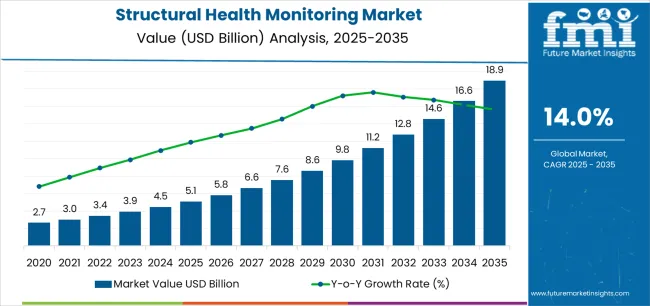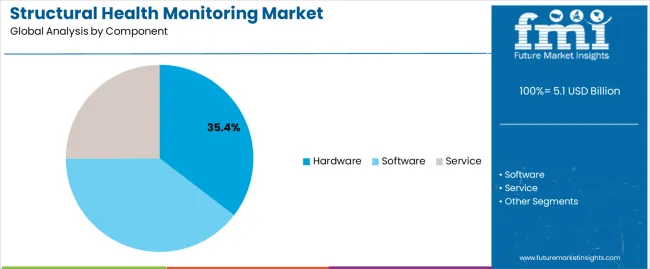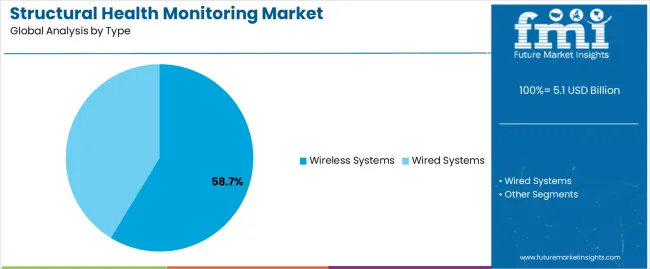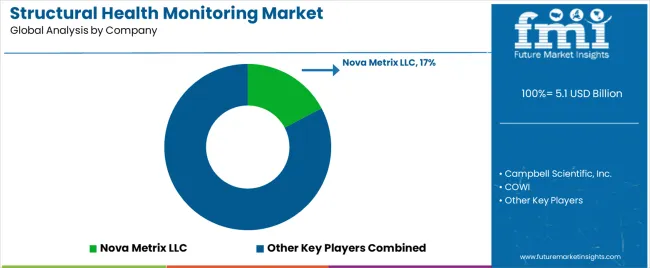The structural health monitoring market is experiencing robust growth. Increasing infrastructure investments, aging civil structures, and the growing need for preventive maintenance are driving demand across multiple end-use sectors. Current market trends indicate strong adoption of smart sensor networks and data-driven monitoring systems that enable real-time structural assessment and safety assurance.
Technological advancements in wireless communication, Internet of Things (IoT), and cloud-based analytics are enhancing system efficiency and reducing maintenance costs. Governments and private infrastructure owners are emphasizing condition-based monitoring to minimize risks and extend the operational lifespan of assets. The future outlook remains positive as global infrastructure modernization projects and sustainability initiatives accelerate implementation of monitoring solutions.
The market’s growth rationale is centered on the integration of intelligent systems, rising regulatory compliance requirements, and the adoption of digital twin and predictive maintenance frameworks These factors collectively ensure long-term reliability, safety, and operational efficiency in critical infrastructure environments.

| Metric | Value |
|---|---|
| Structural Health Monitoring Market Estimated Value in (2025 E) | USD 5.1 Billion |
| Structural Health Monitoring Market Forecast Value in (2035 F) | USD 18.9 Billion |
| Forecast CAGR (2025 to 2035) | 14.0% |
The market is segmented by Component, Type, and Application and region. By Component, the market is divided into Hardware, Software, and Service. In terms of Type, the market is classified into Wireless Systems and Wired Systems. Based on Application, the market is segmented into Bridges And Dams, Buildings And Stadiums, Vessels And Platforms, Airframes And Wind Turbines, and Large Machines And Equipment. Regionally, the market is classified into North America, Latin America, Western Europe, Eastern Europe, Balkan & Baltic Countries, Russia & Belarus, Central Asia, East Asia, South Asia & Pacific, and the Middle East & Africa.

The hardware segment, accounting for 35.4% of the component category, has been leading the market due to its fundamental role in data acquisition, sensing, and transmission. Demand has been supported by widespread deployment of sensors, data loggers, and data acquisition units across bridges, buildings, and industrial structures.
Advancements in sensor accuracy and miniaturization have improved reliability and ease of installation. The segment’s growth is further driven by continuous innovations in microelectromechanical systems (MEMS) and fiber optic sensor technology.
Hardware durability and adaptability to harsh environmental conditions have enhanced its adoption rate in both new infrastructure and retrofit projects Consistent investments in sensor calibration and real-time monitoring equipment have positioned hardware as a critical enabler of comprehensive structural assessment frameworks, ensuring steady expansion within the overall market.

The wireless systems segment, holding 58.7% of the type category, has dominated the market due to its flexibility, cost efficiency, and ease of deployment in large-scale structures. Elimination of complex cabling requirements has reduced installation time and operational expenses.
The segment’s growth is supported by increasing integration of IoT connectivity, cloud computing, and low-power wide-area networks (LPWAN). Wireless monitoring systems enable continuous data collection and remote diagnostics, which are highly valued in bridge and dam monitoring, transportation networks, and industrial facilities.
Enhanced scalability and data synchronization capabilities have strengthened user confidence in wireless configurations With advancements in battery life and communication reliability, the segment is expected to maintain leadership and drive technological evolution in future structural health monitoring solutions.

The bridges and dams segment, representing 34.6% of the application category, has remained dominant owing to the critical need for safety and structural integrity in large-scale civil infrastructures. Increasing incidences of structural degradation and the high cost of failures have accelerated monitoring adoption in these assets.
Continuous assessment through embedded and surface-mounted sensors enables early detection of stress, vibration, and load anomalies. Government mandates and public infrastructure maintenance programs have further boosted implementation rates.
Advanced analytics, integrated with wireless monitoring, are being deployed to provide predictive insights for timely repairs and resource optimization As global infrastructure ages and new construction projects emphasize long-term sustainability, the bridges and dams segment is expected to continue leading adoption, ensuring resilience and reliability in essential infrastructure systems.
Companies constructing structural health monitoring systems are increasingly integrating artificial intelligence and machine learning algorithms to predict the mechanical integrity of buildings. Wireless sensor networks and IoT-enabled devices are also being utilized for real-time monitoring of structures. This saves time and financial capital for the stakeholders.
With technological advancements, construction companies are also using drones and unmanned aerial vehicles (UAVs) for regular inspections and surveys. This helps them understand the condition of the construction site more comprehensively. Apart from this, companies are also adapting to cloud-based structural health monitoring platforms so that engineers and contractors can access the data from anywhere in the world.
Despite such an outstanding growth rate, the market is very likely to face a plunge due to several reasons. One of the main reasons for this slowdown is the high initial costs associated with acquiring and installing structural health monitoring systems.
Companies with limited budgets are likely to refrain from buying these equipment as they may find the traditional ways effective and cost-saving. Another reason impeding the adoption is the lack of skilled workforce.
These machines are often exported from European countries. Engineers and infrastructure development companies have to spend extra capital and training hours to make the workers acquire this technology.
There are still many concerns regarding data security and privacy when it comes to cloud-based monitoring platforms. The market is still in its nascent stages and construction companies are yet not fully satisfied with their efficiency.
Another key deterrent negatively shaping the future of this market is the integration of these modern setups into the existing infrastructure and legacy systems. Companies in the structural health monitoring market must overcome these challenges for promising returns in the future.
On the basis of components, the market is segmented into hardware, software, and services. The software segment is anticipated to hold a share of 38.30% of the overall structural health monitoring market.
| Attributes | Details |
|---|---|
| Component | Software |
| Market Share in 2025 | 38.30% |
The demand for SHM software has skyrocketed in the past few years, especially among government construction companies and projects. Using SHM software, builders can regularly monitor and assess the structural integrity of their projects.
This ensures that the structures constructed are according to the safety standards. These assessments also minimize the risk of accidents and structural failures, which is one of the main concerns for builders.
Based on type, the wired structural health monitoring segment takes the maximum share of the structural health monitoring market. It is anticipated to hold a market value of 62.40%.
| Attributes | Details |
|---|---|
| Type | Wired Structural Health Monitoring |
| Market Share in 2025 | 62.40% |
Wired SHM equipment is being increasingly preferred by builders and contractors as it offers higher reliability and stability compared to wireless alternatives. These equipment are less susceptible to signal loss, hacking, and other interferences, smoothening the construction process.
Their demand in construction and infrastructure development projects is also touching the skies. This is because they provide more precise and real-time data due to the direct and uninterrupted connection between sensors and monitoring devices.
This section offers a comprehensive analysis of the structural health monitoring market across various countries, including Australia and New Zealand, China, Japan, the United States, as well as Germany. The table presents the CAGR for each country, depicting the estimated market growth in these countries until 2035.
| Countries | Forecasted CAGR from 2025 to 2035 |
|---|---|
| Australia and New Zealand | 17.50% |
| China | 14.50% |
| United States | 10.90% |
| Germany | 5.50% |
| Japan | 4.80% |
Australia and New Zealand are expected to exhibit significant growth in the market during the forecast period. The structural health monitoring market in these countries is anticipated to develop at a CAGR of 17.50% through 2035.
Australia and New Zealand are one of the rapidly emerging economies in the world. Governments in these countries are spending billions of dollars to construct new utility buildings, bridges, wind turbines, etc. These constructions require regular monitoring and surveying which automatically fuels the demand for structural health monitoring systems in these countries.
China is also one of the lucrative markets in the East Asian structural health monitoring industry. The structural health monitoring market in China is anticipated to surge at a CAGR of 14.50% through 2035.
China’s economy is significantly impacted by the construction sector. It has also grown significantly since the pandemic. Public as well as private construction companies are increasingly opting for these equipment to minimize structural failures.
With the presence of industry giants in the country, China-based construction companies have access to sophisticated SHM software and equipment. These tools integrate AI and ML algorithms to predict the fallacies in the structures.
The United States also is a promising market in the structural health monitoring industry. Over the next ten years, demand for structural health monitoring in the United States is projected to rise at a 10.90% CAGR.
The United States is currently undergoing a rapid phase of urbanization and population growth. This is primarily due to the rising number of immigrants flocking to the country for education and job opportunities.
This has necessitated companies in the construction sector to adopt sophisticated SHM solutions to ensure the safety and well-being of the residents residing in these newly constructed buildings.
Germany is another rewarding market in the structural health monitoring industry. The market is anticipated to progress at a CAGR of 5.50% between 2025 and 2035.
Germany is filled with old buildings and structures, both in the private as well as in the public domain. These buildings often need comprehensive renovations and structural upgrades to keep up with modern safety standards.
This has driven the demand for structural health monitoring systems in Germany. Besides this, rapid industrialization has also forced construction companies to adopt SHM systems to assess the condition of the buildings regularly.
Japan also exhibits a promising future in the structural health monitoring market. The market in Japan is anticipated to retain its power by progressing at a CAGR of 4.80% till 2035.
Japan has always been facing the problem of natural calamities such as tsunamis and earthquakes. These calamities weaken the structural integrity of the buildings on a regular basis. This is the reason why Japan-based construction companies heavily rely on smart structural health monitoring systems. They use these systems to make sure that their buildings remain resilient and safe against frequent tsunamis and earthquakes.

Nova Metrix LLC, Campbell Scientific, Inc., COWI, Geocomp Corporation, Acellent Technologies, Inc., Sixense, Pure Technologies (Xylem, Inc.), and Digitex are some of the most prominent companies in the structural health monitoring market.
Construction companies, both private and public, rely on the offerings of these companies to monitor and assess their buildings. These companies offer sensors, data acquisition systems, and data analysis and visualization software platforms. They also provide consulting and monitoring services to civil engineering, construction, transportation, and energy stakeholders.
Recent Developments
The global structural health monitoring market is estimated to be valued at USD 5.1 billion in 2025.
The market size for the structural health monitoring market is projected to reach USD 18.9 billion by 2035.
The structural health monitoring market is expected to grow at a 14.0% CAGR between 2025 and 2035.
The key product types in structural health monitoring market are hardware, sensors, data acquisition systems, software, design and analysis, parameter identification and tracking, service, installation service, design and consulting service and operation and maintenance service.
In terms of type, wireless systems segment to command 58.7% share in the structural health monitoring market in 2025.






Full Research Suite comprises of:
Market outlook & trends analysis
Interviews & case studies
Strategic recommendations
Vendor profiles & capabilities analysis
5-year forecasts
8 regions and 60+ country-level data splits
Market segment data splits
12 months of continuous data updates
DELIVERED AS:
PDF EXCEL ONLINE
Bridge Structural Health Monitoring (SHM) Solution Market Size and Share Forecast Outlook 2025 to 2035
Structural Copper Wire Market Size and Share Forecast Outlook 2025 to 2035
Structural Heart Devices Market Size and Share Forecast Outlook 2025 to 2035
Structural Wood Screws Market Size and Share Forecast Outlook 2025 to 2035
Structural Composites Market Size and Share Forecast Outlook 2025 to 2035
Structural Foam Market Size and Share Forecast Outlook 2025 to 2035
Structural Adhesive Market Outlook & Growth 2025 to 2035
Metal Structural Insulation Panels Market Size and Share Forecast Outlook 2025 to 2035
Silicone Structural Glazing Market Size and Share Forecast Outlook 2025 to 2035
Offshore Structural Analysis Software Market Size and Share Forecast Outlook 2025 to 2035
Automotive Structural Steel Market Growth - Trends & Forecast 2025 to 2035
Healthcare Regulatory Affairs Outsourcing Market Size and Share Forecast Outlook 2025 to 2035
Healthcare and Laboratory Label Industry Analysis in the United States Size and Share Forecast Outlook 2025 to 2035
Health and Fitness Club Market Forecast Outlook 2025 to 2035
Healthcare Flooring Market Size and Share Forecast Outlook 2025 to 2035
Healthcare AI Computer Vision Market Size and Share Forecast Outlook 2025 to 2035
Healthcare Business Intelligence Market Size and Share Forecast Outlook 2025 to 2035
Healthcare Master Data Management Market Size and Share Forecast Outlook 2025 to 2035
Healthcare and Laboratory Label Industry Analysis in Japan Size and Share Forecast Outlook 2025 to 2035
Healthcare and Laboratory Label Industry Analysis in Western Europe Size and Share Forecast Outlook 2025 to 2035

Thank you!
You will receive an email from our Business Development Manager. Please be sure to check your SPAM/JUNK folder too.
Chat With
MaRIA